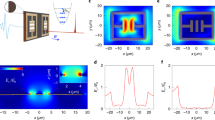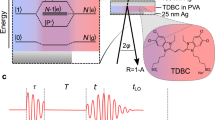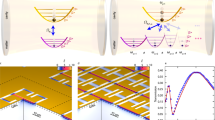Abstract
Controlling the way light interacts with material excitations is at the heart of cavity quantum electrodynamics (QED). In the strong-coupling regime, quantum emitters in a microresonator absorb and spontaneously re-emit a photon many times before dissipation becomes effective, giving rise to mixed light–matter eigenmodes1,2,3,4,5,6,7,8,9,10,11,12. Recent experiments13 in semiconductor microcavities reached a new limit of ultrastrong coupling14, where photon exchange occurs on timescales comparable to the oscillation period of light. In this limit, ultrafast modulation of the coupling strength has been suggested to lead to unconventional QED phenomena14,15. Although sophisticated light–matter coupling has been achieved in all three spatial dimensions, control in the fourth dimension, time, is little developed. Here we use a quantum-well waveguide structure to optically tune light–matter interaction from weak to ultrastrong and turn on maximum coupling within less than one cycle of light. In this regime, a class of extremely non-adiabatic phenomena becomes observable. In particular, we directly monitor how a coherent photon population converts to cavity polaritons during abrupt switching. This system forms a promising laboratory in which to study novel sub-cycle QED effects and represents an efficient room-temperature switching device operating at unprecedented speed.
This is a preview of subscription content, access via your institution
Access options
Subscribe to this journal
Receive 51 print issues and online access
$199.00 per year
only $3.90 per issue
Buy this article
- Purchase on Springer Link
- Instant access to full article PDF
Prices may be subject to local taxes which are calculated during checkout




Similar content being viewed by others
References
Raimond, J. M., Brune, M. & Haroche, S. Colloquium: Manipulating quantum entanglement with atoms and photons in a cavity. Rev. Mod. Phys. 73, 565–582 (2001)
Brennecke, F. et al. Cavity QED with a Bose–Einstein condensate. Nature 450, 268–271 (2007)
Weisbuch, C., Nishioka, M., Ishikawa, A. & Arakawa, Y. Observation of the coupled exciton-photon mode splitting in a semiconductor quantum microcavity. Phys. Rev. Lett. 69, 3314–3317 (1992)
Dini, D., Köhler, R., Tredicucci, A., Biasiol, G. & Sorba, L. Microcavity polariton splitting of intersubband transitions. Phys. Rev. Lett. 90, 116401 (2003)
Reithmaier, J. P. et al. Strong coupling in a single quantum dot-semiconductor microcavity system. Nature 432, 197–200 (2004)
Chiorescu, I. et al. Coherent dynamics of a flux qubit coupled to a harmonic oscillator. Nature 431, 159–162 (2004)
Anappara, A. A., Tredicucci, A., Beltram, F., Biasiol, G. & Sorba, L. Tunnel-assisted manipulation of intersubband polaritons in asymmetric coupled quantum wells. Appl. Phys. Lett. 89, 171109 (2006)
Dupont, E., Gupta, J. A. & Liu, H. C. Giant vacuum-field Rabi splitting of intersubband transitions in multiple quantum wells. Phys. Rev. B 75, 205325 (2007)
Hennessy, K. et al. Quantum nature of a strongly coupled single quantum dot-cavity system. Nature 445, 896–899 (2007)
Schuster, D. I. et al. Resolving photon number states in a superconducting circuit. Nature 445, 515–518 (2007)
Sapienza, L. et al. Electrically injected cavity polaritons. Phys. Rev. Lett. 100, 136806 (2008)
Tsintzos, S. I., Pelekanos, N. T., Konstantinidis, G., Hatzopoulos, Z. & Savvidis, P. G. A. GaAs polariton light-emitting diode operating near room temperature. Nature 453, 372–375 (2008)
Anappara, A. A. et al. Light-matter excitations in the ultra-strong coupling regime. Preprint at 〈http://arxiv.org/abs/0808.3720〉 (2008)
Ciuti, C., Bastard, G. & Carusotto, I. Quantum vacuum properties of the intersubband cavity polariton field. Phys. Rev. B 72, 115303 (2005)
De Liberato, S., Ciuti, C. & Carusotto, I. Quantum vacuum radiation spectra from a semiconductor microcavity with a time-modulated vacuum Rabi frequency. Phys. Rev. Lett. 98, 103602 (2007)
Purcell, E. M. Spontaneous emission probabilities at radio frequencies. Phys. Rev. 69, 681 (1946)
Imamoglu, A., Ram, R. J., Pau, S. & Yamamoto, Y. Nonequilibrium condensates and lasers without inversion: Exciton-polariton lasers. Phys. Rev. A 53, 4250–4253 (1996)
Kasprzak, J. et al. Bose–Einstein condensation of exciton polaritons. Nature 443, 409–414 (2006)
Helm, M. in Intersubband Transitions in Quantum Wells: Physics and Device Applications I (eds Liu, H. C. & Capasso, F.) 1–99 (Academic, 2000)
Yablonovitch, E. Accelerating reference frame for electromagnetic waves in a rapidly growing plasma: Unruh-Davies-Fulling-DeWitt radiation and the nonadiabatic Casimir effect. Phys. Rev. Lett. 62, 1742–1745 (1989)
Kübler, C., Huber, R., Tübel, S. & Leitenstorfer, A. Ultrabroadband detection of multi-THz field transients with GaSe electro-optic sensors: approaching the near infrared. Appl. Phys. Lett. 85, 3360–3362 (2004)
Ferguson, B. & Zhang, X.-C. Materials for terahertz science and technology. Nature Mater. 1, 26–33 (2002)
Tonouchi, M. Cutting-edge terahertz technology. Nature Photon. 1, 97–105 (2007)
Huber, R. et al. How many-particle interactions develop after ultrafast excitation of an electron–hole plasma. Nature 414, 286–289 (2001)
Kröll, J. et al. Phase-resolved measurements of stimulated emission in a laser. Nature 449, 698–701 (2007)
Gaal, P. et al. Internal motions of a quasiparticle governing its ultrafast nonlinear response. Nature 450, 1210–1213 (2007)
Unruh, W. G. Second quantisation in the Kerr metric. Phys. Rev. 10, 3194–3205 (1974)
Hawking, S. W. Black hole explosions? Nature 248, 30–31 (1974)
Sell, A. et al. Field-resolved detection of phase-locked infrared transients from a compact Er:fiber system tunable between 55 and 107 THz. Appl. Phys. Lett. 93, 251107 (2008)
Acknowledgements
The authors wish to thank C. Kübler, S. Leinß, and D. Seletskiy for assistance at an early stage of this experiment, and I. Carusotto for discussions. Support by the Deutsche Forschungsgemeinschaft through the Emmy Noether Program and SFB767 is gratefully acknowledged.
Author information
Authors and Affiliations
Corresponding author
Supplementary information
Supplementary Information
This file contains Supplementary Figure S1 with Legend and Supplementary Notes (PDF 220 kb)
Rights and permissions
About this article
Cite this article
Günter, G., Anappara, A., Hees, J. et al. Sub-cycle switch-on of ultrastrong light–matter interaction. Nature 458, 178–181 (2009). https://doi.org/10.1038/nature07838
Received:
Accepted:
Issue Date:
DOI: https://doi.org/10.1038/nature07838
This article is cited by
-
Electronic transport driven by collective light-matter coupled states in a quantum device
Nature Communications (2023)
-
Entanglement Generated in Quantum Dot-Cavity Coupled System Mediated by Plasmonic Waveguide
Journal of Low Temperature Physics (2023)
-
Temporal loss boundary engineered photonic cavity
Nature Communications (2021)
-
Excitons bound by photon exchange
Nature Physics (2021)
-
Fast amplitude modulation up to 1.5 GHz of mid-IR free-space beams at room-temperature
Nature Communications (2021)
Comments
By submitting a comment you agree to abide by our Terms and Community Guidelines. If you find something abusive or that does not comply with our terms or guidelines please flag it as inappropriate.



